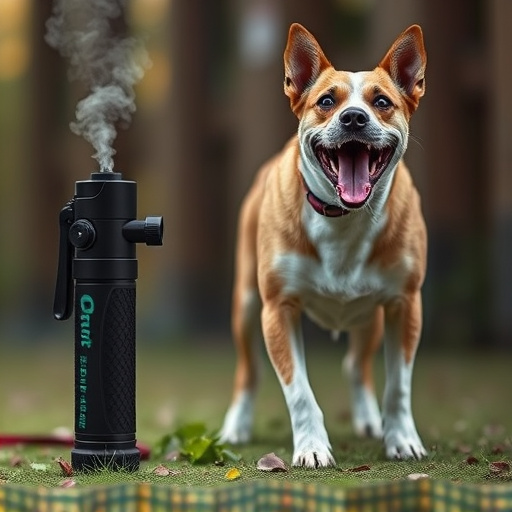Dog repellent spray, a non-lethal self-defense tool, utilizes active ingredients like capsaicin (chili peppers), citronella, black pepper, cayenne pepper, or plant extracts to deter aggressive dogs. Staying calm and backing away while applying these sprays targeting a dog's face—especially eyes and nostrils—can prevent attacks, providing crucial escape time. Choosing products with proven, effective active ingredients is key for personal safety in potential canine threats.
“Staying safe while outdoors should be a fundamental right, but encounters with aggressive dogs can pose significant risks. In such scenarios, understanding self-defense against dog spray is vital. This article equips you with essential knowledge on effective strategies to navigate potentially dangerous situations. From comprehending the mechanics of dog spray to identifying key active ingredients in repellent sprays, we offer insights that could save lives. Learn how to recognize signs of aggression and employ defensive techniques, ensuring your safety during unexpected meetings with our four-legged friends.”
- Understanding Dog Spray: What It Is and How It Works
- Key Active Ingredients in Dog Repellent Sprays
- Effective Self-Defense Strategies When Faced with Dog Aggression
Understanding Dog Spray: What It Is and How It Works
Dog spray, also known as dog repellent spray, is a powerful tool for self-defense against aggressive dogs. Understanding its composition and mechanism is crucial when it comes to effective use. The active ingredients in dog repellent sprays are typically irritants that stimulate the dog’s senses, causing them to avoid or retreat from the area. Common active ingredients include capsaicin, which is derived from chili peppers, and various synthetic chemicals designed to mimic natural irritants.
These irritants are usually non-lethal and safe for humans but can be extremely unpleasant for dogs, triggering their protective instinct to run away. When used correctly, dog spray creates a temporary barrier, allowing the user time to escape or defuse a potentially dangerous situation. Knowing how these sprays work and selecting one with proven active ingredients is essential for self-defense against dogs.
Key Active Ingredients in Dog Repellent Sprays
Dog repellent sprays are designed to deter dogs from approaching or attacking, using a combination of active ingredients that target their senses. The key active ingredients often include capsaicin, which is derived from chili peppers and irritates a dog’s eyes and nose, causing them to back away. Another common component is citronella, a natural oil with a strong, unpleasant odor for dogs but is safe and non-toxic for humans and other animals.
Some formulations also incorporate substances like black pepper, cayenne pepper, or certain types of plant extracts that can further irritate a dog’s mucous membranes. These active ingredients work together to create an effective barrier, ensuring people can defend themselves in the event of an unwanted dog encounter. Understanding these active ingredients is crucial when choosing the right dog repellent spray for personal safety.
Effective Self-Defense Strategies When Faced with Dog Aggression
When faced with dog aggression, knowing effective self-defense strategies is crucial. The first step is to assess the situation and maintain your calm. Avoid direct eye contact, as dogs may interpret it as a challenge, and try to slowly back away while keeping an eye on the dog’s body language. If the dog approaches aggressively, make yourself appear larger by raising your arms or jacket to look bigger without threatening. Yelling at the dog can be counterproductive; instead, use a firm voice commands like “Go home” or “Stop” to deter them.
In terms of active ingredients in dog repellent spray, many options contain capsaicin, the same ingredient found in chili peppers, which stimulates the dog’s eyes and nose, causing them to back away. Other common components include citronella and eucalyptus oil, known for their strong odors that dogs dislike. When using a dog spray, aim for the dog’s face and direct the stream towards their nostrils and eyes. Follow the manufacturer’s instructions for application and be mindful of wind direction to ensure safety.
Dog aggression can be a serious matter, but understanding and employing effective self-defense strategies, combined with knowledge of the active ingredients in dog repellent sprays, can help keep you safe. Always remember to remain calm, assess the situation, and use these tools responsibly. By staying informed about dog spray and its components, you’ll be better equipped to protect yourself when faced with potential canine encounters.
